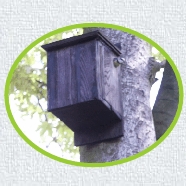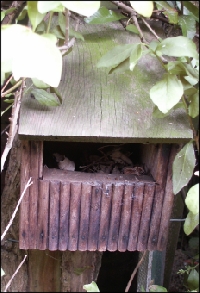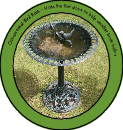|
|
This whole section has been included on our business website to show that business and environmental issues such as bird conservation CAN mix together successfully. A number of our employees are very interested in this subject and have donated time and resources to show how YOU can help make a difference whether at home or at work. Please share this information with your friends and acquaintances and help protect our native wildlife.
|
***Tip - If you have visited this page before - Hit your refresh button twice to get the very latest version***
GARDEN BIRDS - HOW TO HELP THEM
BUILDING A NEST BOX....Why not make this a school woodwork project? - Make something that really matters!!
The designs below are not particularly special or unique and do not need the services of a master joiner to build, BUT they do work and give a good combination of facilities to ensure the best possible outcome. However, life for birds is TOUGH and you should expect some failures due to predation (cats, sparrowhawks, squirrels, magpies, jays, crows, woodpeckers et al). This is very sad and some would say "natural" but there is a lot you can do to minimise losses due to predation as explained below. The fact is that if you have taken the time to build a box, put it in the right location and then watch two birds set up a territory and rear young, you get intensely involved, become very defensive and there is nothing "natural" at all about the demise of "your" nest!
Other factors affecting success are: lack of disturbance, plentiful supply of the right type of food, quality of parents (some are better than others) and of course the weather. All of these factors play a part in determining the success or otherwise of any nesting attempt, but without a box, any sort of box, whether at home or at work, you will miss out on the fascinating experience of watching a small family grow up! So get building!
BUILDING THE BOX Imagine you were going to build a single room apartment in a rough neighbourhood and you couldn't afford much in the way of heating - what would you build?
Your apartment would:
|
Our bird family have exactly the same wish list so build the box as though YOU were going to live in it for a while!
TOOLS: Saw, hammer, drill, assorted wood bits (25mm + 28mm + 32mm), wood plane, pencil + ruler.
MATERIALS: Various offcuts of wood from a local joinery shop, rubber inner tube or pond liner offcut (lid hinge), brass fixing screws, white PVA glue (lots), nails, brass hinges (lid) and lid fixing catch.
 |
 |

Hello - I'm a blue tit and |
Other Nest Box Designs.....Sparrow terrace box.....Experimental side by side multi species box
 |
 |
 |
|
|
|
FOOD - What to feed and when....Back to Top
You should feed birds all year round since they grow to depend on you. Feeding live foods (waxworms, mealworms etc.) is a bonus especially during breeding time and once the starlings get to find them - you will need buckets full as other birds will not get a look in!! To avoid this problem, use a special feeder with an adjustable top section that can be lowered to allow access to small birds but not starlings. A better solution is to have oak trees nearby since these have the greatest number of green caterpillers though you will need to be patient if you decide to plant one. Some of the tamer species ie robins & blackbirds will occasionaly get so used to being fed that they will follow you around the garden and DEMAND feeding! Some robins can be trained to feed from the hand using live foods but this is rare and takes lots of patience (we have though!).
It is true that mealworms do wriggle and can be a bit intimidating, but, they are the BEST source of food for baby birds in the garden. Mealworms do not smell and are vegetarian so they are safe to use. The best way to store them (but don't tell the wife), is in the salad container at the bottom of the fridge. They will keep for at least a month in here so keep costs down by buying in bulk from a specialist supplier - our local one is Livefoods Direct and pick the standard size variety. We are lucky enough to still have a sizeable house sparrow population and they go absolutely nuts whenever we put some mealworms out.
Winter months can be very hard as natural sources of food become scace so hang up some fat cakes for them to eat during the colder months.
As a general feeding plan: Put out the following foods (in order of preference):
Live foods especially at breeding times (May - June) in a starling proof feeder
Sunflower hearts in a tube feeder - buy the largest feeder you can afford as most birds love sunflowers and don't forget to add a tray underneath to catch most of the bits
Cheap breakfast oats either scattered on ground or in container
HB Canary seed mix (Haiths) - either on a birdtable or scatter around as sparrows are wary of food placed in heaps
Crushed peanuts on paved areas (sprinkle on floor & jump on them)!
Crumbled bread & biscuits on floor
Whole peanuts in feeder
Cheap dried sultanas
Fat cakes especially during Autumn - Spring. How to make a fat cake
What to feed sorted by species (in order of preference based on our own data):
|
 |
|
|
|
|
||
|
|
 |
|
|
|
|
|
All these foods are "no waste" and the birds will hoover them up in alarming quantities especially at breeding times. Feed in a secure area where cats are unable to hide, yet where cover is close nearby to escape from hawks. Be patient when just starting - it can take sparrows especially up to six weeks to find and accept a new source of food. Be aware that sunflower hearts and wet weather combine to produce a foul smelling mush - clean up occasionaly! If buying whole sunflower seeds - the black ones are prefered but be advised, the shells will need to be cleaned up regularly (however they can be composted). Larger birds such as feral pigeons, wood pigeons, collard doves etc. can become a problem as they compete aggressively with smaller birds for food, eat huge amounts and can be difficult to persuade to feed elsewhere.
PREDATION....Back to Top
Birds face many enemies in the wild, some of which you can do very little about as they are protected by law, but others can be succesfully defeated. Rats, mink and grey squirrels will eat any egg or small bird they can find and are a serious threat, but the biggest preditor by far is the domestic cat which can be difficult to keep out of the garden. However, there are a number of things you can do:
- Water cannon - works well for all predators especially cats and is fun to use!
- Low powered catapults firing soft, non lethal objects are effective.
- Electronic cat detector - also works well but needs to be permanently wired (do not rely on batteries).
- Various pepper and chemical sprays - patchy results.
- Audible devices ie bells fixed to the cats collar can help but need to be in groups - a single bell won't work as the cat will learn how to stalk without the bell making a sound.
- Fencing - In many ways this can be the best solution as a robust chain link fence will stop the dash and grab through the hole in the hedge type attack. It also prevents similar attacks by sparrowhawks. The higher the fencing, the more difficult it is to surprise the birds in your garden. Choose a link size to allow a blackbird to just squeeze through.
- Do not feed near areas that predators can hide in or behind.
- If birds have enough warning of an attack, they can usually get away safely.
- Attacks by other predators such as rats, mink, magpies, grey (but not red) squirrels, crows and jays are more difficult to predict and plan against. If you are serious about protecting against these, learn some new recipes!!
- Sparrowhawk predation is increasing as the population is growing. Not a lot can be done against this wonderfully agile bird as it is fully protected by law and is a magnificent sight in full dash. However, blocking up concealed flight lines through trees, hedges and bushes with wire mesh fencing of the right gauge, will allow smaller birds to fly straight through whilst the hawk has to waste time making a detour and allow time for escape. Similarly, building bolt holes by encasing your hedges or shrubs in a large gauge wire mesh makes it impossible for the hawk to get at the sheltering birds. Be warned though, sparrowhawks have incredibly long legs (6" 150mm) so your hedge needs to be reasonably wide to defend against attacks from both sides and allow escapees to shelter safely in the middle. Over time, the mesh will be absorbed into the plant and will become invisible. This is also a very useful technique to protect nests from predators such as cats, foxes and magpies even if you only treat sections of your hedges. Plastic fencing will deter hawks, cats and other birds but you need a strong metal mesh to keep out foxes and squirrels - plastic coated metal is OK.
NEST SITES - Where birds build nests and how to encourage them....Back to Top
Plants that will attract birds or provide places to nest
Ivy - Great food source (insects) and provides plenty of nest sites and shelter
Privet - Not that good but much improved if mixed with hawthorn and pyracantha to give an evergreen dense thorny hedge
Pyracantha - Thorn bush - Great as a hedge and provides berries to eat as well (red berries preferred)
Oak - The best large tree to have. Harbours a multitude of insects and caterpillers
Fir - Tall fir trees especially with a columnar shape and dense foliage provide ideal nest sites
Hawthorn - Great as a hedge especially if left a little ragged and long. Mix with an evergreen if desired
Holly - Excellent as a roost site and evergreen
Beech - Makes nice hedging and homes for blackbirds but deciduous and slow growing
Rhodedendrum - Large shrub that provides lots of shelter and cover
Azalea - As rhodedendrum
Essential for nest building in spring - Mud!
Improve it by adding some 2-4" lengths of chopped course grass and keep damp (otherwise it will set like an Egyptian brick)!! If there is water nearby and plenty of insects, you might attract a house martin or swallow to share your hospitality.
Scatter some feathers around - ideally from a recently deceased dove, magpie or pigeon. Sparrows especially will take huge quantities of these and are comical to watch as they try to fly away.
Blackbirds pair up early in spring and establish territories with dominant or experienced birds getting the best places in terms of food sources and nest sites. Other pairs may set up around the dominant pair but may not have access to good quality nest sites and may have to compromise. A little human help can make a large difference in this case by providing plenty of the right types of nest locations such that a higher proportion of successful nests will result and the population will increase. By planting the right types of shrub and tree, you can really make a difference and encourage many types of bird to nest.
Blackbirds usually build in a hedge (almost any type) where they like plenty of cover but are not too fussy over the height. They are opportunists and will use a shelf in a shed or any quiet space. The nest is made from a base of any old rubbish - grass, paper, plastic and anything else to form a platform. There can be an amazing amount of material used in this phase of the nest. Next comes an inner cup of mud mixed with grass or fibres to form a strong container. The female bird makes this by plastering new bits of material onto the existing structure and then settling down and puffing out her breast to make the right shape. Finally, the inside is lined with some finer grass and hair, perhaps a few feathers and that's it - done. The very first attempt each year can be quite a dismal affair and they seem to need a bit of practice to get it right.
Usually 4 eggs are laid and to get three young out of the nest is a good achievement. Babies are a light brown colour and speckled, gradually getting darker with age. Always check hedges before cutting them to avoid exposing a new nest to predators. Watch out for magpies, squirrels or cats trying to raid the nest or attack the fledglings - the parent blackbirds will normally make lots of noise which will warn you they need help - quickly!
Like robins, blackbirds can become very tame and trusting, especially if you feed them frequently and it can be difficult to avoid falling over them sometimes as they get so close.
Blackbirds tend to move out mid - late Summer to gorge on soft fruits if available in local hedgerows - Blackberries, Elderberries etc., only moving back into your feeding environment when this food source is exhausted - early Winter. So you may see many blackbirds including lots of new youngsters around daily but these may all vanish almost overnight and in good years (plenty of fruits), they may be gone for up to three months. Watch out for them returning. Of course if you are near an abundance of soft fruit, this behaviour may not be noticed as the birds stay (why move)?
Both like to nest tucked well inside a tree, dense hedge or bush. Greenfinches love loosely clipped hawthorn hedges and tall conifer trees with a dense type of growth. Goldfinches will nest in any tall shrubbery that is sufficiently dense. Be careful of summer pruning as you may disturb these birds or even dislodge a nest.
Two fledglings are normal and three very good. Babies of both types are very noisy when chasing parents for food. Late broods of greenfinches have an unusual behaviour of getting out of the nest and putting themselves on the ground close to a source of food where they look very lethargic even ill or poisoned. They will spend all day on the ground, right up to late dusk and have been regularly seen to tuck their head under a wing and fall fast asleep during the daytime right where they are. If you approach slowly and quietly, they will even let you stroke them before waking up and ambling off a short distance without being the least bit disturbed - strange! This behaviour is a protection from sparrowhawks which don't seem to realise a meal could be so easy to catch and almost always miss them. Cats though are a different matter and they are very vunerable at this stage.
Dunnocks (Hedge Sparrows)....Back to Top
Any dense bush or shrub will do. Dunnocks produce a compact, tidy nest of grass, lined with finer material and seem to pick good locations, certainly much better than blackbirds. Their primary natural food source is tiny seeds and insects which are needed in abundance for the young when hatched.
House Sparrows.....Latest research.....Sparrow nestbox design.....BBC report
Dramatic declines in the numbers of house sparrows are being recorded though the reason is not yet established conclusively. Lack of food and suitable nest sites are a factor as are losses due to the domestic cat and a rise in predation by an increasing sparrowhawk population is not helping matters, so any help for this little bird is a bonus.
Sparrows nest in any hole or crack especially in man made buildings where they can be close to an easy source of food. Naturally they eat various seeds and insects though they can be notoriously slow to even try a new food source. Modern building construction methods have all but eliminated anywhere for the sparrow to nest so although you might feed them, numbers cannot grow enough to sustain a population. The answer is to provide plenty of nest boxes though make sure they are quite high - sparrows love to be around 5m up as they try (unsuccessfully) to remain elusive during the breeding season. They are social birds forming large clans with a well defined pecking order and don't mind in the least nesting in close colonies which makes either a sparrow terrace nest box or eaves box ideal. Try scattering some loose feathers around the garden in spring. These act as magnets to sparrows who will travel long distances to get them and they take huge quantities to line their nests (comfy warm duvet). It is really comical to watch as they try to fly away. The best feathers to use are quite small and light coloured - from birds such as magpies, collard doves and pigeons, perhaps killed by a fox or other "accident".
Sparrows are a bit of a "utility" bird! Not very bright either to look at or mentally, but they are funny to watch. If you ever get the chance to see a young sparrow as it finds its first ever frog, watch it closely. Initial fear soon gives way to curiosity as the bird edges nearer to the stationary frog. The frog perceiving a slight threat will stir and move away a little with a short hop that frightens the bird away, though not far. It seems this leaping action excites and intrigues the sparrow so much that it comes right back and starts dancing around the frog in circles, looking at it from every angle. At this point the frog usually loses interest and stays perfectly still and after a while the sparrow, having established this creature is no threat, does one of two things - it either moves away or gives the frog a sharp peck on its back legs. This last action really gets things moving as the frog puts in a much bigger jump and the sparrow now genuinely alarmed flies off to somewhere safer.
Sparrows need patience as they can be very wary and a new food source might be rejected for five or six weeks before they finally get used to it on their own. This can be really frustrating - especially if trying to introduce live foods into the diet during breeding time. Starlings are a good catalyst for sparrows as they always dive in first with sparrows following. This is true for nest sites as well so don't be too disheartened if nothing happens immediately but be patient.
Other Observations - Seen in 2000 at St. Peters Port Guernsey - Sparrows on the sea front marina have learned to have a sweet beak! Watched a number of sparrows target cafes with outside tables that had sugar bowls on them and feed from the sugar. Not hygenic but interesting to watch during morning tea (unsweetened)!
Robins.....Typical robin nest location.....Closeup
An open fronted nest box set deep within a climbing ivy or thick hedge will interest most robins, as will an old teapot, saucepan or box but make sure that water cannot collect in the bottom. Baby robins are very curious and this can make them accident prone so cover over any stored water and try to stop them getting trapped behind things.
Some robins can become extremely tame and will reward patience on your part with trust on theirs. If you become aware that a robin is following you around, deliberately slow down your actions and allow the robin time to get used to you. Eventually it will decide you are no threat and will get even friendlier. A few of its favourite white grubs (or mealworms) will eventually prove too good to miss and it will come to your hand - we know - we have done this and it works! There is little to compare with gaining the trust and confidence of a fully wild creature and watching it feed contentedly from your hand.
Robins are very musical and have a wonderful range of songs including a curiously quiet, almost inaudible but very melodious version of their territorial song. In fact it sounds as though the bird is a long way off when in fact it is immediately behind you on a branch or in a hedge - strange - and hard to believe it isn't singing just for you! Another sound to listen out for is the alarm or warning call - A rapid and loud tick - tick - tick repeated many times. Good indication of when the sparrowhawks or local cats are around.
Fiercely territorial, robins have been known to fight to the death and can be extremely aggressive to other birds. Two robins in the same area are almost guaranteed to be a pair although it is difficult to tell which is which as they look almost identical.
Have similar nesting requirements to sparrows but need bigger entrance holes. Starlings tend to be very bold and are almost always the first to try any new food source, showing the other birds the way. Unfortunately this usually means that all the food vanishes since they come in large numbers and clear everything up. Other than during breeding time, they like to stay in large but loose flocks and many hundreds of birds can collect in one place to roost. Starlings have an aggressive, argumentive nature yet can be comical to watch as they try to steal food from each other. Many hundreds of birds sometimes descend on a grassy area to feed together and have an unusual technique of finding food such as leatherjackets by stabbing the soil, then opening the beak wide and sensing any movement. They can be a very messy bird in late summer when feeding on soft fruits, especially elderberries.
Tits....Back to Top
Both blue and great tits will readily use nestboxes IF they are in the right place and around the right size. Get the location or size wrong and you will be perpetually frustrated as the birds check out the box each year, do a little housework on it (peck the hole etc.) and then choose to nest somewhere else. If you get things just right, they will be very loyal, returning each year to delight you with their antics. Try a number of boxes around your area so that they at least have a choice but be aware that blue tits are fiercely territorial and will fight most things that get too close. Don't, for this reason, put blue tit boxes near feeding areas. Great tits though aren't so bothered and will tolerate other birds to get quite close to the nest. You can mix boxes and put a great tit and blue tit box fairly close together - though how close is still being researched with a special double box (Experimental side by side multi species box) set up for great and blue tits.
Nest success is very variable for this family of birds and depends greatly on the weather. They have an "all or nothing" type strategy for rearing young and generally nest only once each year though with a large brood, timing their breeding cycle to co-incide with the spring flush of caterpillers and insects. Really good years can produce six or even more youngsters who having left the nest, make a lot of noise as their frantic parents try to keep them all fed. Cold damp conditions make keeping chicks warm and well fed with insects very difficult and large numbers can die as a result. Second broods may be attempted in really bad years if the first brood fails. Sunflower heart seeds and livefoods mixed together in a starling proof dry feeder can literally make the difference between life and death for the chicks during such difficult times. Be careful with peanuts though and if feeding these, make sure they are smashed up (either in a food processor or put in a plastic bag and hit with wooden object ie rolling pin or baseball bat). Never ever feed dessicated (dried) coconut as this can swell up inside the chick and kill it.
Coal, marsh and long tailed tits might have similar requirements but although seen quite often, none have ever nested here so no experience. Coal tits have been observed carrying large quantities of sunflower seeds away to adjacent areas and burying them. All tits eat huge quantities of small insects and caterpillars especially when rearing young and are very beneficial for the garden.
Be aware that your nest box could be used as a night roost especially on cold winter nights so leave them up all year round (how would you like it if you came home and found your house was missing)?!
This bird is nice to look at, extremely adaptable and very intelligent. Its diet is mainly scraps and invertebrates (worms and creepy things) but during the breeding season it becomes a real menace to smaller birds as it destroys eggs and chicks in large numbers. A few magpies here and there are OK - dozens in and around your area are really bad news and will decimate the local bird population either through direct predation or through intimidation. Blackbirds in particular suffer heavily at the beaks of magpies as does the now rare song thrush.
It's nest is a heavily fortified construction in the top of a tree complete with roof.
Misc
Feathers scattered around in April / May / June time will be appreciated by all the birds to help with nest building. They prefer light coloured ones, white is favorite.
Many proprietry (ready mixed) packs of wild bird seeds contain large grains - wheat, maize etc which tend to be eaten by larger birds, so if you want to encourage pigeons and similar birds, these foods work well.
Table scraps such as rice, potato, pastry and meat scraps such as chicken carcasses are also welcomed by the birds but you need to use some care. Do not put this type of food out late at night or in massive quantities as you might encourage rats. Having said that, the local fox population will clear most leftovers very quickly and most birds seem to like boiled rice.
Catch 22
OK - so hopefully reading this page has inspired you to build some bird boxes and start feeding them as well - excellent! This will give you many hours of pleasure, especially if you stick at it over the months to come and start to see the local bird population grow in numbers. Be prepared for a war though. As your birds multiply, so do the predators and this can be quite distressing, especially if they become skillful at working your patch. So make sure you have plenty of safe places for birds to feed and shelter as described elsewhere. Ideally, thin out the predators if possible or practicable to make it easier for our smaller garden birds to recover numbers and maintain a healthy balance. The "dawn chorus" is not as loud as it used to be but the situation is not beyond recovery if we all help a little.
Baby Birds....Back to Top
- Are hardly ever abandoned so leave them alone unless you KNOW both parents are dead. Seek proper advice.
- Are very vunerable so protect from predators - keep the cat in.
- Have got no experience of life and do silly things. If one gets close to a road or other hazard and seems to be heading for trouble, resist the urge to pick it up (this will stress the bird) but rather put yourself inbetween the bird and the danger. Slowly walk towards it and it will try to move away from you. Leave in a safe position. Only pick it up as an absolute last resort as you are liable to kill it through stress.
- Do best if hidden in a thick bush - Pyracantha (thorn bush) is excellent.
- Cover over anything that contains water with a fine mesh.
- Help them by putting out SUITABLE food for the parents to find and deliver. Not too close though.
- Are unaware that you are their friend - they think you are just another predator and will try to run away from you. Do not chase baby birds as they are more likely to end up in an unsafe location. Watch out for them.
Note that all the information presented above is based on direct observations and practical experience gathered over many years. Nothing written here is copied from other books, magazines or webpages. All photographs and observations are genuine and firsthand so you can be assured of absolute authenticity.
If you appreciated this information and the time we spent gathering and presenting it, send a small donation:
Birdtours Website - Hundreds of Bird Watching trip reports from all around the world.
Audio Equipment Products for the disabled.
Auction Goods - Our "bargain basement" of goods going "cheep" (oooh!)
Can't hear the TV properly? Want to listen without disturbing the rest of the family or neighbours?
Other value links - Manufacturers, services and PC software.





